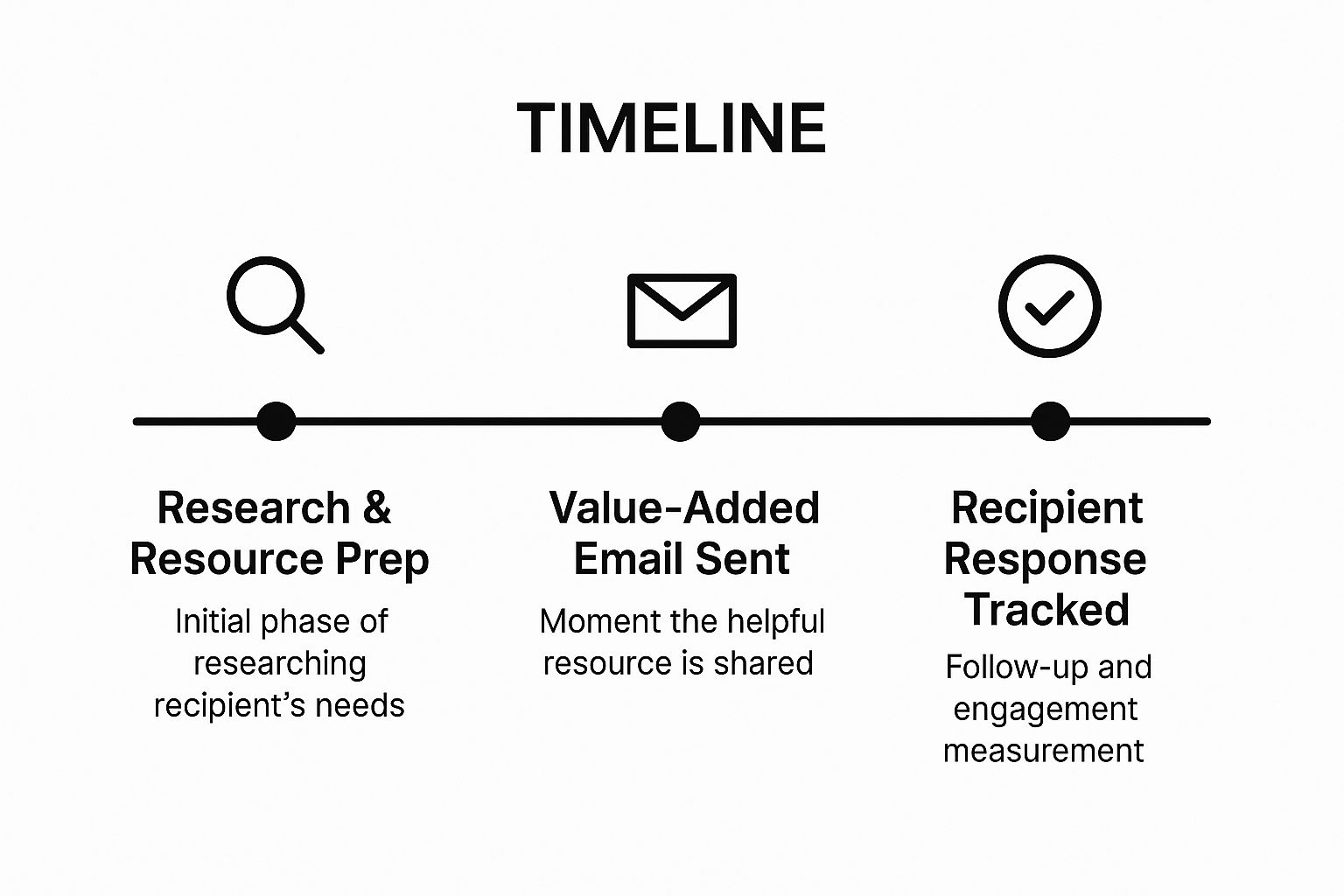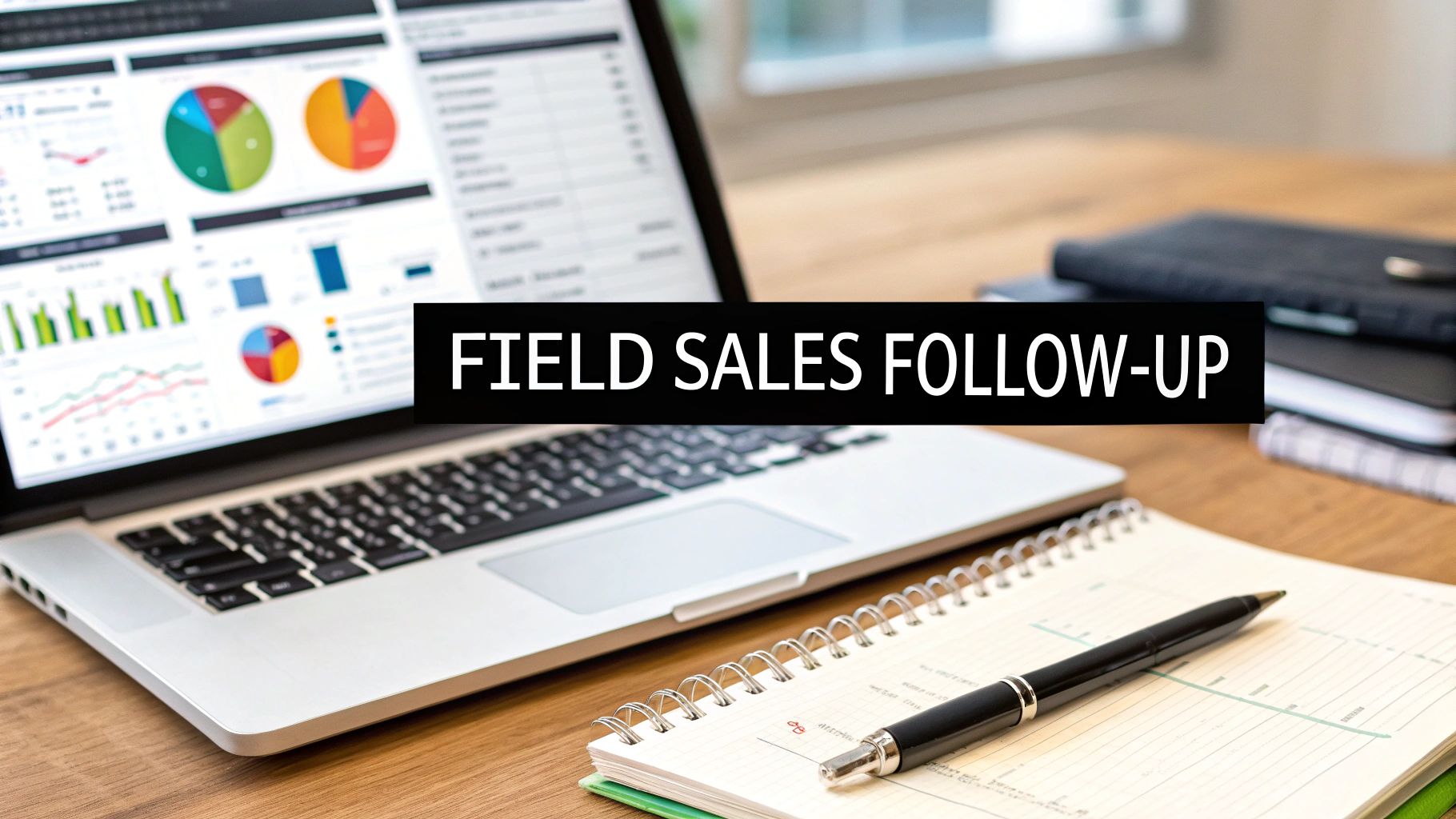Unlocking Field Sales Success: The Power of the Follow-Up
In field sales, consistent and strategic follow-up is crucial for converting leads into customers. This listicle provides six actionable follow-up email samples, complete with strategic analysis and tactical insights, to help you master the art of the follow-up. We'll dissect what makes each email effective, providing replicable strategies you can use immediately. Learn how to craft compelling follow-up emails that resonate with your prospects and drive sales. This article offers practical examples, demonstrating how to use follow-up emails effectively in your field sales process. We'll cover diverse scenarios, from initial check-ins to closing the deal, giving you the tools to boost your conversion rates. You'll find follow up email samples tailored for field sales professionals like you. Specifically, we'll explore these essential follow-up strategies:
- The Friendly Check-In Follow-Up
- The Value-Added Follow-Up
- The Urgency-Based Follow-Up
- The Social Proof Follow-Up
- The Breakup Email
- The Question-Based Follow-Up
Stop letting leads slip through the cracks. Transform your follow-up process and start maximizing your sales potential today. This comprehensive guide will empower field sales teams in various industries, including home services, telecommunications, energy, and more, to refine their follow-up strategy and boost their bottom line. We’ll move beyond generic templates and dive into the strategy behind successful follow up email samples.
1. The Friendly Check-In Follow-Up
The Friendly Check-In Follow-Up is a powerful tool in the field sales arsenal. It's a non-aggressive email designed to gently nudge a prospect without the hard sell. Instead of directly pushing for a sale, it prioritizes nurturing the relationship and re-engaging the prospect with your previous conversation or proposal. This subtle approach keeps you top-of-mind and can reignite interest without alienating potential customers.

Why It Works
This follow-up email sample excels because it focuses on providing value and building rapport. By showing genuine interest in the prospect's needs and offering helpful resources, you position yourself as a trusted advisor, not just another salesperson. This approach is particularly effective for long sales cycles and relationship-focused industries like home services, telecommunications, and energy.
Examples of Success
- HubSpot's customer success team: Uses check-ins to maintain client relationships and identify opportunities for upselling or cross-selling. This proactive approach strengthens customer loyalty and drives revenue growth.
- Salesforce representatives: Employ friendly check-ins for long-term prospect nurturing, staying engaged even when prospects aren't immediately ready to buy. This persistence often pays off when the prospect's needs evolve.
- Real estate agents: Use check-ins with past clients for referral generation, capitalizing on existing relationships to build their business. This strategy leverages trust and goodwill to generate new leads.
Actionable Tips for Implementation
- Personalize: Include specific details from previous conversations. Referencing past discussions shows you've listened and value their time.
- Ask Questions: Include a genuine question about their current situation or challenges. This demonstrates your interest and opens the door for further conversation.
- Add Value: Share relevant industry insights, articles, or resources. Providing valuable information positions you as a helpful resource.
- Keep it Brief: Focus on relationship building, not pushing for a sale. Respect their time and avoid overwhelming them with lengthy emails.
When and Why to Use This Approach
The Friendly Check-In is ideal for several scenarios:
- After an initial meeting: Reconnect and reaffirm your interest.
- Following a proposal submission: Gently remind them of your offer and offer to answer any questions.
- When a prospect goes silent: Re-engage without being pushy.
- For long-term lead nurturing: Stay top-of-mind and build rapport over time.
This approach is especially valuable for field sales teams managing numerous leads across various territories. Consistent, personalized follow-up is crucial for converting leads into customers. Tools like lead management software can streamline this process and ensure no prospect falls through the cracks. Learn more about...
This follow-up email sample deserves its place on this list because it emphasizes the importance of building genuine connections. By focusing on relationships, you build trust and increase the likelihood of converting prospects into long-term customers. This strategy is particularly effective in the Canadian market, where personalized service is highly valued.
2. The Value-Added Follow-Up
The Value-Added Follow-Up is a strategic approach to follow-up emails that focuses on providing genuine value to the prospect. Rather than simply checking in or pushing for a sale, this method prioritizes sharing helpful resources, insights, or solutions relevant to the prospect's specific needs or challenges. This positions the sender as a trusted advisor and expert, fostering a stronger relationship and increasing the likelihood of engagement.
Why It Works
This follow-up email sample is effective because it shifts the focus from selling to serving. By offering valuable information tailored to the recipient's needs, you demonstrate genuine interest in their success. This fosters trust and credibility, making the prospect more receptive to your message and increasing the likelihood of a positive response. This approach is especially beneficial in complex sales environments where building long-term relationships is essential.
Examples of Success
- Marketing consultants: Sharing industry reports with prospects demonstrating their market expertise and offering valuable insights. This positions them as thought leaders and increases their credibility.
- Software vendors: Providing free trials or personalized demos to showcase their product's value and allow prospects to experience the benefits firsthand. This removes barriers to entry and encourages conversions.
- Business coaches: Offering complimentary assessment tools to identify areas for improvement in the prospect's business. This provides immediate value and establishes the coach's expertise.
Actionable Tips for Implementation
- Research: Thoroughly understand the recipient's industry, current challenges, and specific needs. This allows for targeted value delivery.
- Share Value: Offer truly helpful content, not just generic marketing materials. The resource should directly address the prospect's situation.
- Contextualize: Explain how the provided resource specifically relates to their situation and potential benefits.
- Follow Up: After sharing the resource, follow up to inquire about its helpfulness and open further conversation.

The infographic above visualizes the three key stages of the Value-Added Follow-Up: initial research and resource preparation, sending the value-added email, and finally tracking the recipient’s response and engagement. This timeline demonstrates the importance of a planned and strategic approach to maximizing the effectiveness of this follow-up method.
When and Why to Use This Approach
The Value-Added Follow-Up is particularly effective in these scenarios:
- After a discovery call: Provide relevant resources that further address the prospect's identified needs.
- When a prospect expresses a specific challenge: Offer tailored solutions or insights that demonstrate your expertise.
- During a long sales cycle: Maintain engagement by consistently providing value and staying top-of-mind.
- For building long-term relationships: Position yourself as a helpful resource, fostering trust and loyalty.
This approach is especially relevant for field sales teams working with businesses in Canada, where building rapport and providing personalized service are highly valued. Efficient lead routing is crucial for maximizing the impact of this strategy. Learn more about...
This follow-up email sample deserves its place on this list due to its emphasis on building genuine connections by offering tangible value. By focusing on the prospect's needs and demonstrating expertise, you establish trust, differentiate yourself from the competition, and significantly increase the likelihood of converting leads into long-term customers. This approach is effective for follow up emails samples.
3. The Urgency-Based Follow-Up
The Urgency-Based Follow-Up is a strategic approach designed to propel prospects toward a decision by introducing a time-sensitive element. This method leverages the psychological principle of scarcity, suggesting limited availability or approaching deadlines to encourage prompt action. It’s a powerful tool when used ethically and appropriately, but requires careful consideration to avoid seeming pushy or manipulative.

Why It Works
This follow-up email sample works because it taps into the fear of missing out (FOMO). By highlighting a limited-time offer, expiring discount, or approaching deadline, you create a sense of urgency that can motivate prospects to act quickly. This approach is particularly effective in competitive markets or when dealing with price-sensitive customers.
Examples of Success
- SaaS companies: Successfully utilize trial expiration reminders to convert free users into paying subscribers. This creates a clear deadline, prompting users to evaluate the software's value and commit to a purchase.
- Event organizers: Employ early-bird pricing deadlines to drive early registrations and secure guaranteed attendance. This incentivizes prompt action and helps with event planning and logistics.
- Retailers: Leverage flash sale notifications to generate immediate sales and clear out inventory. This creates a sense of excitement and encourages impulsive buying behavior. Canadian retailers, particularly during seasonal promotions, see considerable success with this tactic.
Actionable Tips for Implementation
- Be Genuine: Ensure the urgency is real. Fabricated scarcity damages trust and credibility.
- Highlight the Value: Clearly explain the benefits of acting quickly. What are they missing out on if they delay?
- Provide Clear Instructions: Make it easy for prospects to take the desired action. Include direct links and concise instructions.
- Test Different Approaches: Experiment with various urgency tactics to determine what resonates best with your target audience in Canada.
When and Why to Use This Approach
The Urgency-Based Follow-Up is best suited for specific situations:
- Limited-time promotions: Drive sales during special offers or discounts.
- Time-sensitive events: Encourage registrations or ticket purchases.
- Product launches: Generate initial buzz and early adoption.
- Trial expirations: Convert free users to paid subscribers.
For field sales teams, particularly those operating door-to-door or at events, creating urgency can be a key driver of on-the-spot sales. Learn more about... The immediacy of the interaction lends itself well to urgency-based tactics.
This follow-up email sample earns its spot on this list because it acknowledges the importance of timing in the sales process. By strategically introducing urgency, you can accelerate decision-making and increase conversion rates. However, remember to use this tactic responsibly and ethically, always prioritizing the customer relationship. In the Canadian market, building trust is paramount, so ensure your urgency tactics don't compromise the long-term relationship.
4. The Social Proof Follow-Up
The Social Proof Follow-Up leverages the powerful psychological principle of social proof to influence potential customers. This strategy showcases testimonials, case studies, or success stories from similar clients or situations to build credibility and demonstrate proven results. By highlighting the positive experiences of others, you build trust and encourage action, making it an invaluable tool for field sales teams.

Why It Works
This follow-up email sample is highly effective because it taps into the innate human tendency to follow the lead of others. When prospects see that others in similar situations have benefited from your product or service, they're more likely to believe in its value. This approach is particularly impactful in competitive markets where building trust is paramount. Social proof offers tangible evidence of your claims, strengthening your message and making it more persuasive.
Examples of Success
- B2B software companies: Share customer success metrics, showcasing quantifiable results like increased efficiency or cost savings. This data-driven approach resonates with decision-makers focused on ROI.
- Marketing agencies: Showcase client campaign results, highlighting successful strategies and the positive impact they've had. Visual examples of past successes can be very compelling.
- Professional services firms (e.g., consultants, lawyers): Highlight client testimonials, emphasizing the value and expertise provided. Positive client feedback builds trust and credibility.
Actionable Tips for Implementation
- Relevance: Choose case studies most relevant to the recipient's industry and specific needs. Tailoring your examples increases their impact.
- Measurable Results: Include specific, measurable results whenever possible. Quantifiable data adds weight to your claims.
- Permissions: Get proper permissions before using client names or testimonials. Respecting client privacy is essential.
- Connect to Needs: Directly connect the social proof to the recipient's potential needs and challenges. Show them how your solution has helped others overcome similar obstacles.
When and Why to Use This Approach
The Social Proof Follow-Up is ideal in several key scenarios:
- After a needs assessment: Provide relevant case studies that address the prospect's identified challenges.
- Following a product demo: Reinforce the value proposition by showcasing successful client implementations.
- Overcoming objections: Use social proof to address specific concerns or hesitations a prospect may have.
- Building confidence in your offering: Demonstrate the tangible benefits of your product or service through the experiences of others.
This approach is particularly valuable for field sales teams in Canada, where relationship-building and trust are highly valued. By leveraging the power of social proof, you provide prospects with the confidence they need to choose your offering. This strategy resonates strongly with Canadian consumers who often rely on word-of-mouth referrals and peer recommendations.
This follow-up email sample deserves a spot on this list due to its ability to establish credibility and build trust effectively. By showcasing tangible results and leveraging the influence of others, the Social Proof Follow-Up can significantly increase your conversion rates. This approach is especially powerful for field sales teams targeting small to mid-sized businesses (SMBs) and those managing numerous leads across various territories.
